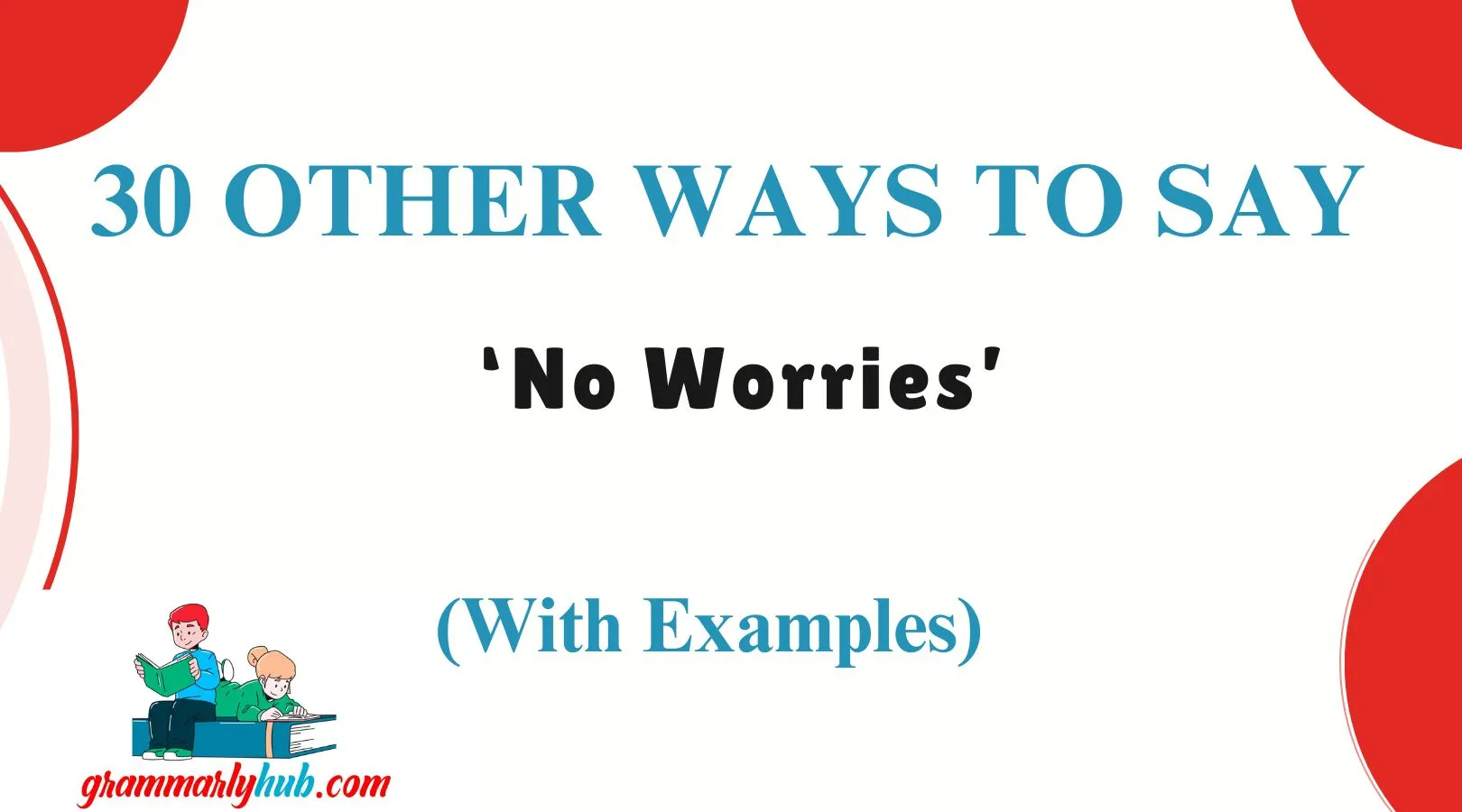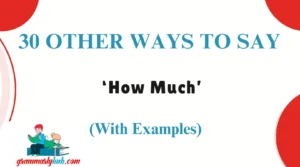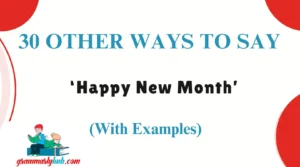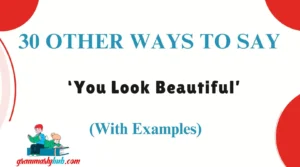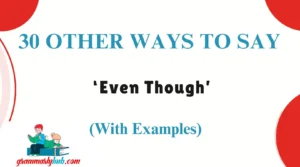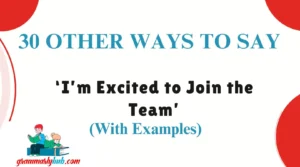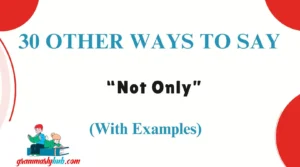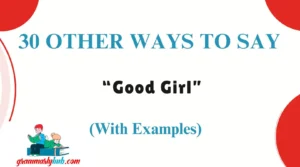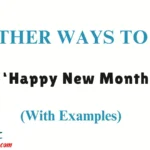When it comes to expressing reassurance and easing someone’s concerns, finding the right words can make all the difference. Saying “no worries” is often used to show that everything is okay and that the other person doesn’t need to feel concerned. However, there are many other thoughtful and warm alternatives that can make your message feel more personal and meaningful.
Whether you’re trying to lighten the mood, offer comfort, or simply acknowledge someone’s gratitude, these alternatives allow you to communicate with care, ensuring that your words resonate with the listener in a more empathetic way.
In this article, we’ll explore 30 different ways to say ‘no worries’, each with its own tone and use case. Let’s dive into these unique expressions and find the ones that best suit your style!
What Does “No Worries” Mean?
“No worries” is a phrase often used to reassure someone that they don’t need to feel anxious, apologize, or be concerned about something. It expresses a sense of calm, understanding, and support. It’s a way to say that everything is fine or that a situation has been resolved in a stress-free manner. This expression can help soothe nerves and create a relaxed, friendly atmosphere.
When to Use “No Worries”
You might use “no worries” in casual situations to ease tension or let someone know that there’s no need for concern. It’s appropriate when someone apologizes for something minor or expresses gratitude. It’s best used when you want to let others know that everything is taken care of or that they don’t need to stress about a small matter.
Is It Professional/Polite to Say “No Worries”?
While “no worries” is a great informal phrase for casual conversations, it may not be ideal in more formal or professional settings. In these cases, it might be better to choose more polite or neutral alternatives to avoid sounding too relaxed or dismissive. Use it with colleagues you have a close relationship with, but it’s best to avoid it in formal emails or meetings unless you’re sure of the tone.
Pros and Cons of Saying “No Worries”
Pros:
- Creates a relaxed and friendly atmosphere.
- Helps reassure others quickly and easily.
- Builds a positive and approachable image.
Cons:
- May seem too casual or informal in some professional contexts.
- Can be perceived as dismissive if overused.
“No Worries”Synonyms
- Not a problem
- No trouble at all
- It’s all good
- My pleasure
- Don’t mention it
- Glad to help
- You’re welcome
- Anytime
- All good
- No big deal
- Sure thing
- Happy to help
- Forget about it
- That’s okay
- It’s fine
- No sweat
- You’re all good
- Absolutely
- Of course
- Totally fine
- Consider it done
- It happens
- You’re fine
- That’s no issue
- It’s no bother
- Don’t worry about it
- Not at all
- We’re good
- That’s alright
- No problem at all
1. No Problem
Definition: A casual way of saying that something isn’t an issue or inconvenience.
Explanation: Used to reassure someone that their request or concern is easily manageable.
Scenario Example: “Thanks for helping me with that! No problem at all.”
Worst Use: In formal or highly professional settings, it might sound too laid-back.
Tone: Casual, friendly.
2. It’s All Good
Definition: A phrase that conveys that everything is fine and no issues exist.
Explanation: Often used to calm someone down when they apologize or feel worried.
Scenario Example: “I’m sorry I’m late!” “It’s all good, don’t worry about it.”
Worst Use: In tense situations, where a more serious approach is needed.
Tone: Relaxed, assuring.
3. Don’t Worry About It
Definition: A phrase used to tell someone that there’s no need to worry or feel concerned.
Explanation: Reassures someone that they don’t need to stress over a minor issue.
Scenario Example: “I accidentally bumped into your car.” “Don’t worry about it, it’s nothing!”
Worst Use: When the situation requires more serious attention or accountability.
Tone: Casual, comforting.
4. No Trouble at All
Definition: Expresses that whatever was asked of you was easy to do and not an inconvenience.
Explanation: Commonly used to reassure someone after a request has been fulfilled.
Scenario Example: “Thanks for lending me your notes.” “No trouble at all!”
Worst Use: If the action was genuinely a burden or troublesome.
Tone: Friendly, polite.
5. It’s Fine
Definition: A simple phrase that indicates that everything is okay and there’s no problem.
Explanation: Used to acknowledge someone’s apology or concern with reassurance.
Scenario Example: “Sorry I’m late.” “It’s fine, no worries.”
Worst Use: In very serious situations where more empathy is needed.
Tone: Easygoing, neutral.
6. No Big Deal
Definition: Suggests that something isn’t a problem or isn’t worth worrying about.
Explanation: Commonly used to downplay any inconvenience.
Scenario Example: “Sorry for taking so long.” “No big deal at all!”
Worst Use: If the issue at hand is significant and needs acknowledgment.
Tone: Casual, nonchalant.
7. It’s Okay
Definition: Reassures someone that everything is acceptable or that there’s no need for concern.
Explanation: Often used to express that something is alright, even if there was an issue.
Scenario Example: “I didn’t mean to offend you.” “It’s okay, don’t worry.”
Worst Use: In high-stakes situations where more attention is needed.
Tone: Comforting, gentle.
8. Everything’s Under Control
Definition: Indicates that a situation is being managed or is in good hands.
Explanation: Reassures someone that everything is being handled and there’s no need to worry.
Scenario Example: “Do you need help with that?” “Everything’s under control, thank you!”
Worst Use: When things are genuinely not under control.
Tone: Confident, assuring.
9. No Sweat
Definition: A way of saying that something is no trouble or doesn’t cause any stress.
Explanation: Often used to convey that the task at hand is easy or unimportant.
Scenario Example: “Can you help me move this weekend?” “No sweat, I’ve got you covered.”
Worst Use: When the task is more complex or time-consuming.
Tone: Laid-back, supportive.
10. All Good
Definition: Indicates that everything is fine, okay, or under control.
Explanation: Commonly used in casual conversations to show reassurance.
Scenario Example: “Sorry, I spilled your drink.” “All good! It happens.”
Worst Use: In formal contexts or serious matters.
Tone: Relaxed, understanding.
11. Glad to Help
Definition: A kind way to say you were happy to assist.
Explanation: Shows not just a lack of inconvenience, but also joy in offering support.
Scenario Example: “Thanks for fixing my laptop!” “Glad to help, anytime.”
Worst Use: When you weren’t actually glad—it might sound insincere.
Tone: Cheerful, helpful.
12. It Was Nothing
Definition: Emphasizes that your help or action required little effort.
Explanation: Softens the situation and assures it wasn’t burdensome.
Scenario Example: “I really appreciate your help!” “It was nothing.”
Worst Use: When the effort was actually significant—can downplay your own boundaries.
Tone: Modest, calm.
13. Don’t Mention It
Definition: A polite way to say thanks isn’t necessary.
Explanation: Shows grace and humility, common in formal or semi-formal exchanges.
Scenario Example: “Thanks for your kind words.” “Don’t mention it.”
Worst Use: With close friends—it may feel overly formal or distant.
Tone: Courteous, classic.
14. No Harm Done
Definition: Reassures that nothing bad happened, so there’s no need to worry.
Explanation: Great after small mistakes or misunderstandings.
Scenario Example: “I dropped your book.” “No harm done, really.”
Worst Use: When harm was actually done.
Tone: Forgiving, reassuring.
15. Not a Problem
Definition: Clarifies that what occurred isn’t troubling you.
Explanation: Close in tone to “no problem” but can sound slightly more formal.
Scenario Example: “Thanks for rescheduling.” “Not a problem at all.”
Worst Use: In highly sensitive contexts—it may not express enough empathy.
Tone: Neutral, friendly.
16. I’ve Got You
Definition: A comforting way to say someone can count on you.
Explanation: Adds a sense of protection and presence.
Scenario Example: “Can you handle that task?” “I’ve got you covered.”
Worst Use: When you’re unsure if you can follow through.
Tone: Confident, supportive.
17. You’re All Good
Definition: A casual way to say that someone hasn’t upset you or done anything wrong.
Explanation: Lightens the mood and diffuses tension.
Scenario Example: “I forgot to text back!” “You’re all good, no stress.”
Worst Use: May sound dismissive in serious discussions.
Tone: Chill, upbeat.
18. It’s Cool
Definition: Expresses acceptance and calm.
Explanation: Often used in laid-back conversations among peers.
Scenario Example: “Sorry for the delay!” “It’s cool, I get it.”
Worst Use: In formal work situations—too relaxed.
Tone: Casual, informal.
19. Not an Issue
Definition: Tells someone their concern didn’t cause a problem.
Explanation: Slightly more professional than “no problem.”
Scenario Example: “I hope I didn’t cause trouble.” “Not an issue, honestly.”
Worst Use: In emotional situations—it may sound detached.
Tone: Reassuring, polite.
20. It Happens
Definition: Acknowledges that mistakes are part of life.
Explanation: Good for when someone feels bad about a small slip-up.
Scenario Example: “I forgot to bring the file!” “It happens, don’t worry.”
Worst Use: In professional settings—it may sound too casual.
Tone: Compassionate, laid-back.
21. Totally Fine
Definition: Emphasizes that everything is absolutely okay.
Explanation: Adds reassurance and emphasis to ease concern.
Scenario Example: “I missed the meeting.” “Totally fine, we caught you up.”
Worst Use: When it’s not totally fine—it can feel passive-aggressive.
Tone: Relaxed, understanding.
22. We’re Good
Definition: Expresses that the relationship or situation is unaffected.
Explanation: Often used to indicate forgiveness or mutual understanding.
Scenario Example: “Sorry for snapping earlier.” “We’re good, really.”
Worst Use: When clarity or deeper conversation is needed.
Tone: Friendly, informal.
23. You’re Fine
Definition: Reassures the person that their behavior or action is acceptable.
Explanation: Calms the other person when they’re feeling guilty or unsure.
Scenario Example: “Did I offend you?” “You’re fine, don’t worry.”
Worst Use: Can feel dismissive if not said sincerely.
Tone: Soft, calming.
24. Forget About It
Definition: Tells someone not to dwell on something.
Explanation: Good for brushing off something unimportant.
Scenario Example: “Sorry for the mix-up.” “Forget about it, no biggie.”
Worst Use: If someone needs clarity or closure.
Tone: Casual, dismissive (depending on tone).
25. No Drama
Definition: Indicates that the issue won’t be blown out of proportion.
Explanation: Often used among friends to reassure there’s no tension.
Scenario Example: “Sorry if I was being too much.” “No drama, you’re good.”
Worst Use: With people who expect serious discussion.
Tone: Easygoing, light-hearted.
26. It’s Not a Biggie
Definition: Another way of saying the issue is not significant.
Explanation: Softens the situation and reduces guilt.
Scenario Example: “I messed up your coffee order!” “It’s not a biggie.”
Worst Use: In professional environments—it may sound too juvenile.
Tone: Friendly, informal.
27. All’s Well
Definition: Reassures that everything is in good order.
Explanation: More poetic or old-fashioned, but warm and comforting.
Scenario Example: “Is everything okay?” “All’s well, truly.”
Worst Use: With people who might not understand the phrasing.
Tone: Gentle, affirming.
28. Cool With Me
Definition: Confirms acceptance of a situation or decision.
Explanation: Commonly used to agree with someone’s action or request.
Scenario Example: “Can we reschedule?” “Cool with me.”
Worst Use: When professionalism is required.
Tone: Informal, relaxed.
29. All Sorted
Definition: Indicates that a situation has been taken care of.
Explanation: Great for giving someone peace of mind after a mishap.
Scenario Example: “Did you fix the error?” “All sorted!”
Worst Use: When the issue hasn’t actually been resolved.
Tone: Reassuring, confident.
30. Absolutely No Worries
Definition: An emphatic version of “no worries” to show total ease.
Explanation: Shows strong reassurance and friendliness.
Scenario Example: “Sorry to change plans last-minute.” “Absolutely no worries, I get it.”
Worst Use: When you do actually feel concerned—it could be misleading.
Tone: Warm, expressive.
FAQs:
1. Can these phrases be used in both casual and professional settings?
Yes! Many of these alternatives to “no worries” work well in both informal conversations and professional emails, depending on the tone. For instance, “Not a problem” or “Glad to help” fits well in workplace settings, while “It’s cool” or “No biggie” are better suited for casual chats.
2. Are these phrases culturally appropriate around the world?
Most of them are widely accepted in English-speaking cultures, but always be mindful of the tone and cultural norms. A phrase like “Forget about it” might be warm in the U.S., but confusing or abrupt in more formal cultures. It’s best to match your phrase to the context and the people you’re speaking with.
3. Which alternative sounds the most professional?
If you’re in a business environment, phrases like “Not an issue,” “Don’t mention it,” or “Glad to help” carry a respectful and positive tone. These choices express support and politeness without sounding too casual.
4. How do I choose the right alternative?
Think about your relationship with the person, the tone of the conversation, and the context. If someone seems anxious, something comforting like “You’re all good” might help. If you’re replying to a thank-you email at work, “Happy to help” or “Not a problem” would be better suited.
5. Is “No Worries” still okay to use?
Absolutely. The phrase “No worries” is still widely loved and commonly used. This list simply gives you more variety to keep your communication thoughtful, warm, and adaptable to different moments.
Conclusion:
Finding the right words can turn a simple moment into something more meaningful. Saying “No worries” is a lovely way to show ease and kindness—but sometimes, choosing a fresh, thoughtful alternative can elevate your message and deepen connection. Whether you’re writing an email, texting a friend, or smoothing over a misunderstanding, these 30 expressive alternatives give you the flexibility to match your words with the moment.
From “Not a problem” to “You’re all good,” each phrase shared here is more than just a replacement—it’s an invitation to speak with empathy, clarity, and intention. Language shapes relationships, and even the smallest phrase can leave a lasting impact. So next time someone says thank you or apologizes, reach for a response that feels authentic, warm, and true to you.

Welcome to GrammarlyHub, your go-to destination for mastering grammar, improving your writing, and finding the best language tools available online. Founded by Emma Rose, a passionate writer and advocate for clear communication, GrammarlyHub was built to help people express themselves with confidence and accuracy.
